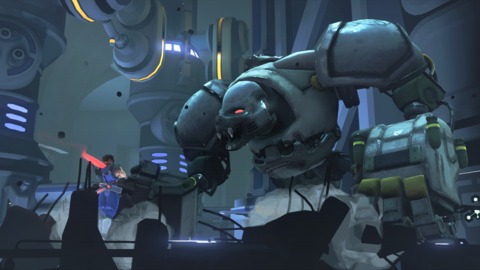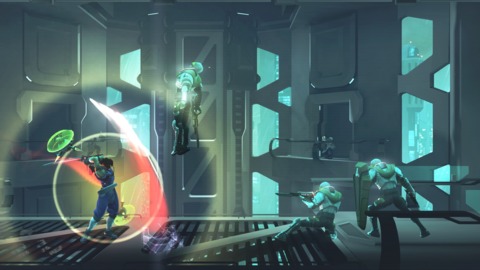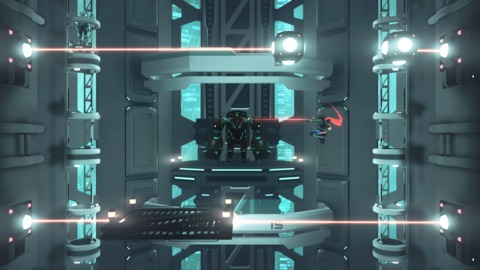After years of rumors and little slices of information about games that were canceled before they were even announced, Capcom has finally put together a brand new Strider. 2014's Strider sees Hiryu after Grandmaster Meio in a reboot of the arcade game's basic plot, setting, and many of its major encounters. It's thin on story, long on mashing the attack button, and a mostly satisfying endeavor that left me wishing that it had more of a plot or that more of the game required actual expertise and skill, rather than being able to mash your way through 90 percent of the game's combat.

There's no preamble to Strider. Launch the game and you'll quickly find yourself hang-gliding into Kazakh City and receiving one simple objective: "Assassinate Grandmaster Meio." As you make your way around the city and into a handful of different areas, you'll get other sub-objectives to help you proceed, but finding Meio and putting his lights out is your goal. Along the way you'll get occasional (and annoying unstoppable, even on retries) dialogue from bosses, but other than telling you that your journey is about to end in defeat, most of the bosses don't have anything meaningful to say. It's just as well, as most of the voice work is average, at best.
While the setting and many of the boss encounters are inspired directly by the arcade version of the game, the action is a bit more like the more-thoughtful NES release or, if you want to be modern about it, it's a Shadow Complex-like action-adventure where you earn abilities that help you enter previously inaccessible areas of the world. This gates access to later portions of the game and also gives you a reason to backtrack around the game to find doors that you weren't able to open the last time around. You'll get most of your major gear upgrades from boss encounters, and most of these are taken directly from the original game and given a few twists to bring them up a bit closer to modern standards. If nothing else, it's a pleasure to be able to fight a giant mechanical ape one more time, even if you can just run up next to it and mash the attack buttons to win.

Most of the gear is very straightforward, though a set of plasma types for your standard sword attack let you deal explosive, ice, magnetic, or standard damage. Your standard attacks can also reflect bullets back at turrets and other armed enemies, once you've found the appropriate upgrade. Traversal doesn't change too much over the course of the game, though gaining the ability to double jump is certainly nice. It gives you an extra bit of maneuverability that freshens up the combat a bit, giving you a better way to dodge bullets. Of course, on normal difficulty you needn't bother. Running right at most enemies and bosses and swinging your sword as quickly as possible is typically the only strategy you need, and the game doesn't start throwing trickier boss encounters at you until the final third. Even the final boss is felled by some fairly remedial tactics. Keeping that in mind, you might want to bump it up to hard... but this seems to just tweak the damage numbers a bit and doesn't really make the game any more exciting.
At times, Strider looks great, but it would benefit from some more environmental variety. Aside from some early bits on the rooftops and some airship shenanigans, most of the game is set in a series of fairly plain-looking facilities. Without many big landmarks to help you navigate, it's a good thing the game has an effective map, complete with color-coded doorways to help you figure out what it takes to open each door--handy when you're backtracking for additional items. The audio, other than the occasionally lame voice acting, is good, but on my 5.1 setup the PS4 version had a really rotten sound mix, with music primarily pumping out of the rear speakers and things like the "shing" of your sword slash, dialogue, and other combat-related audio quietly coming out of the center channel. For the record, this setup has been fine for plenty of other PS4 games, but I would have to make some major adjustments to individual channel volume to make this game sound anything close to correct. Unless maybe the audio team know how drab the dialogue was and tried to buried under a few layers of sound...

The game spits out a trophy for finishing the game in under three hours, but after doing a bit of hunting around to collect around 75 percent of the total items and running up against the game's tougher bosses, my time was a little closer to five hours. Some of the items you'll find along the way include concept art and some unlockable challenges. Beacon Run is a checkpoint race against the clock that gives you a preset loadout of items for each challenge, to keep things fair. Survival mode is a combat challenge that sends you up against waves of bad guys and, again, keeps time for you. Those times are posted to online leaderboards along with your completion time for the campaign. I didn't find either of the two extra modes to be all that exciting, but it's nice that there's something other than the main chunk of action to play.
I went in feeling really great about Strider. It opens abruptly and gets right down to business. The control feels good and the combat starts out in a pretty satisfying way. But, over time, those positives wear off. The game doesn't do enough with its additional items, areas, and action to make it feel like a steady challenge and the variety in the action is a little lacking. It's still a good time if you're the type of person who wants anything that resembles Metroid, modern-day Castlevania, or anything in-between. With more variety to its combat and some more time spent smoothing out its rough edges, Strider could have been a significantly better game.